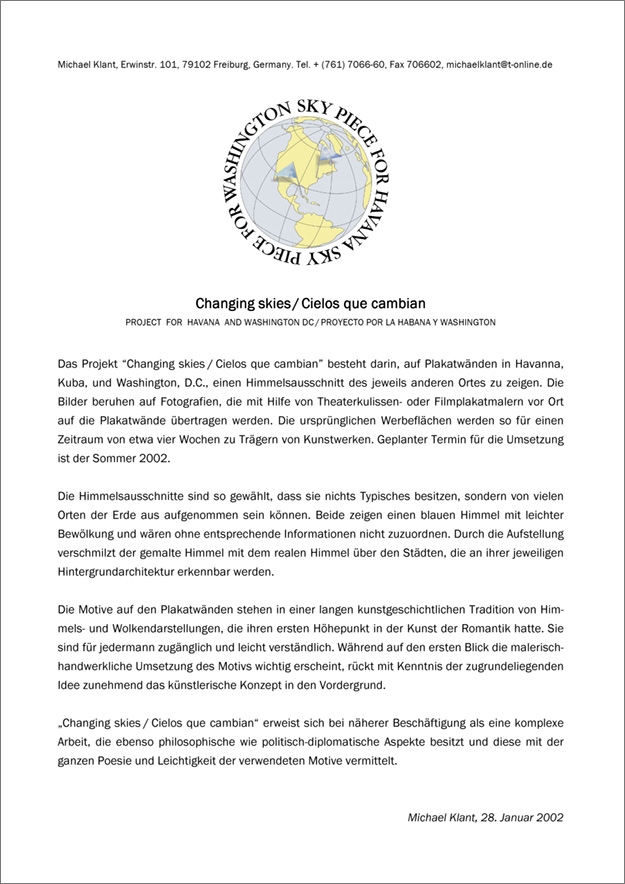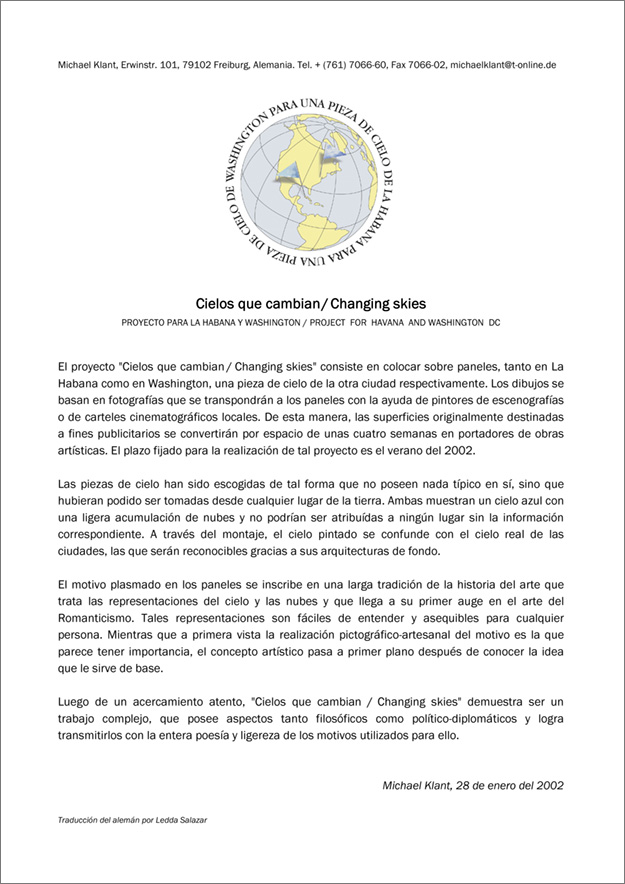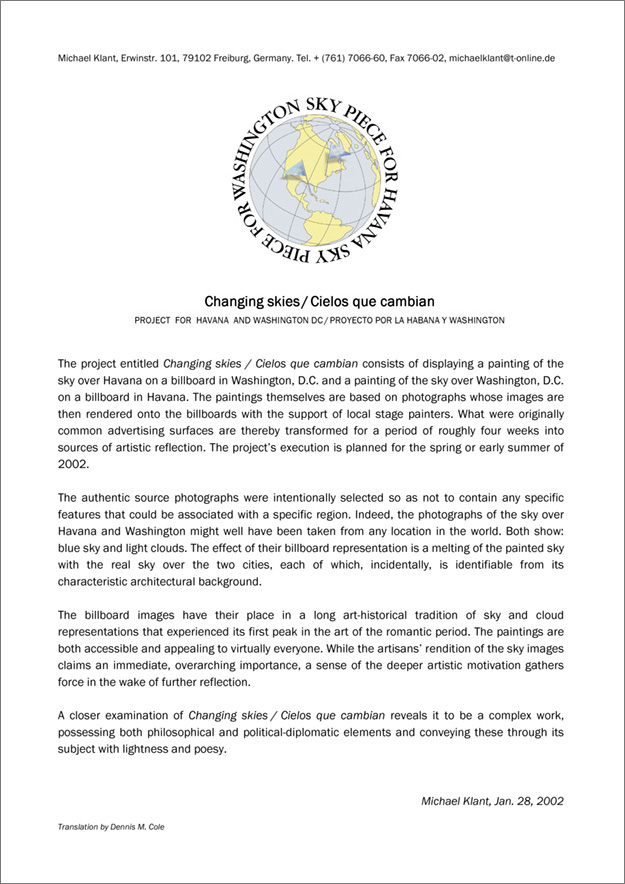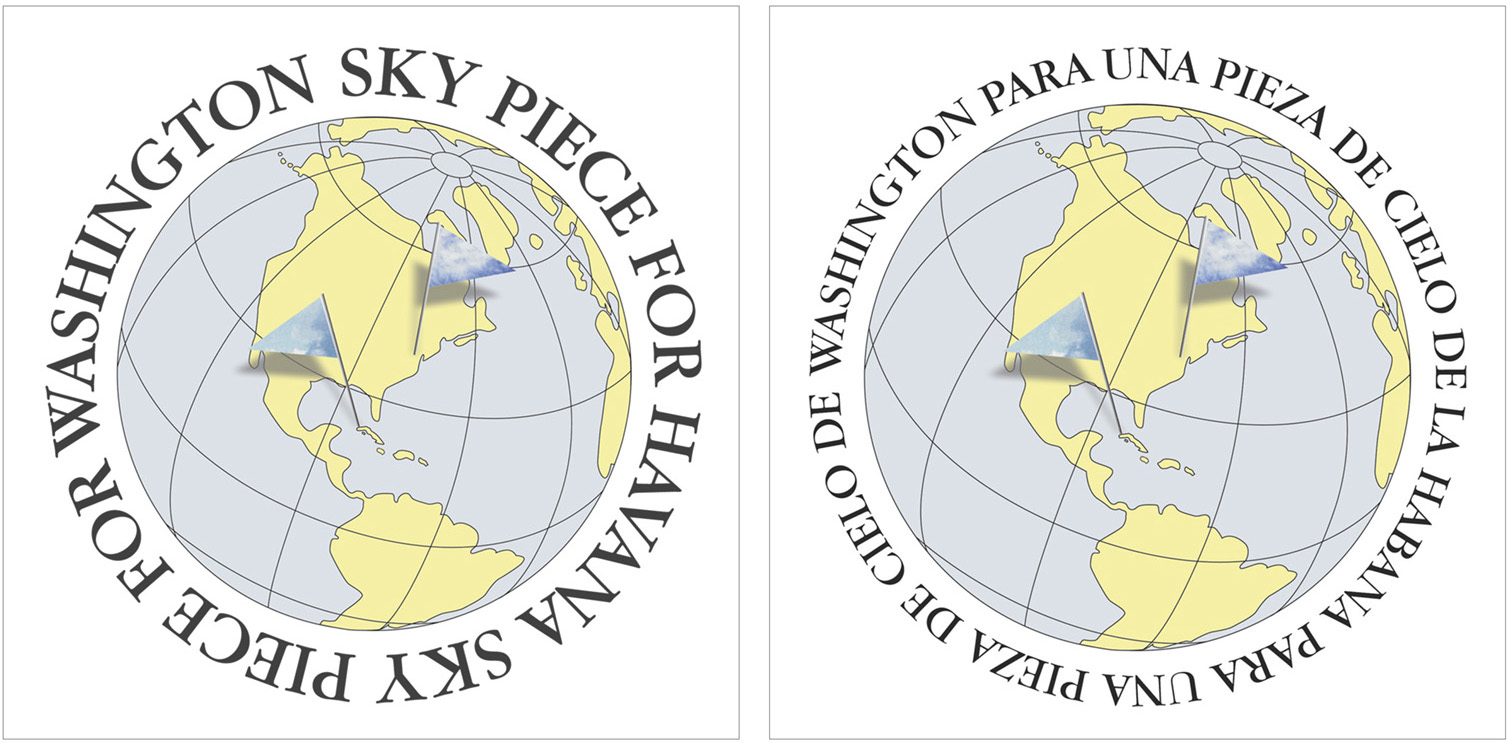
Changing Skies – The Havana Washington Billboard Project / Cielos que cambian – Proyecto con vallas publicitarias para La Habana y Washington, 2002. Siebdrucke / silkscreen prints, je / each 70 x 70 cm
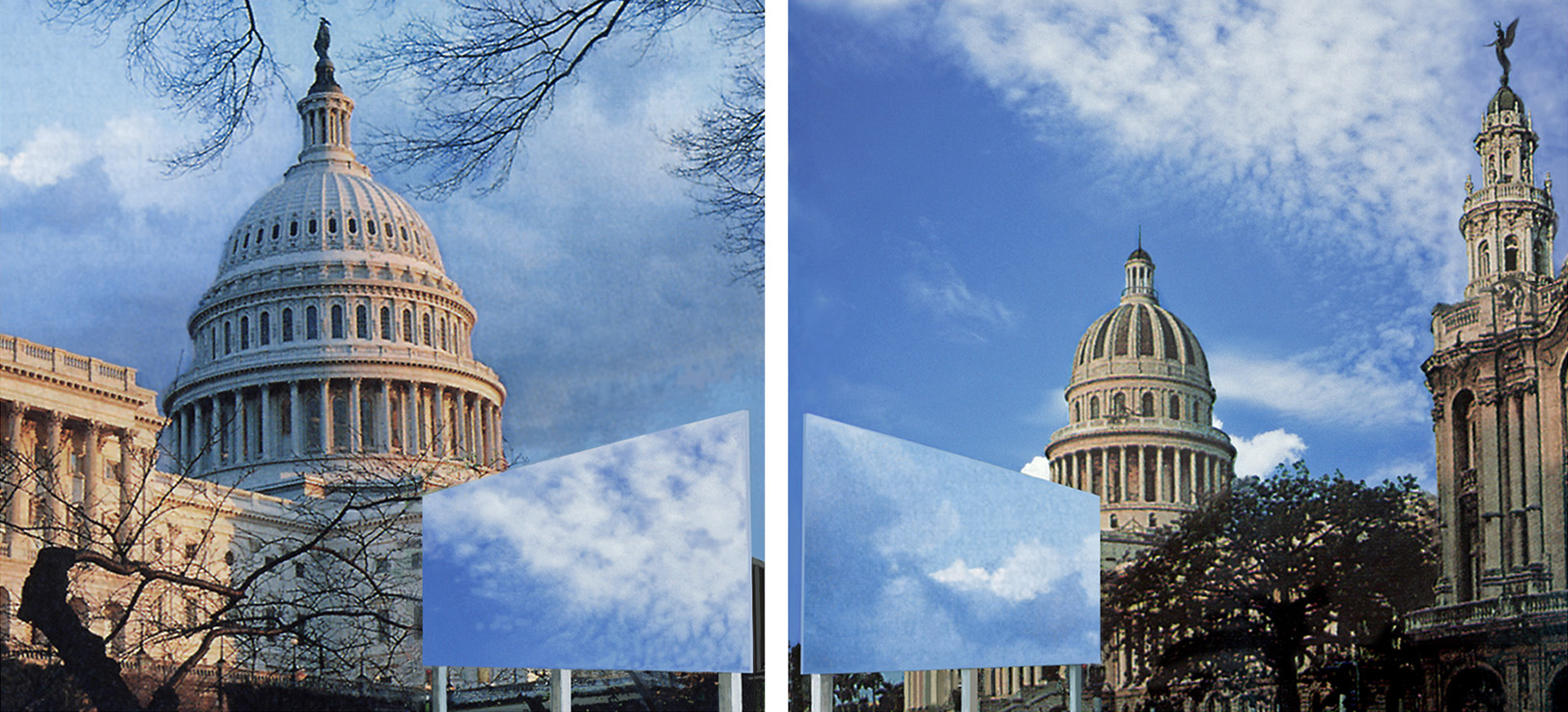
Changing Skies — The Havana Washington Billboard Project / Cielos que cambian — Proyecto con vallas publicitarias para La Habana y Washington, Photomontage 2001/2002
Die Projektidee entstand durch die Erkenntnis, dass es aufgrund des Kalten Kriegs keine direkte Reiseverbindung zwischen den USA und dem kommunistisch regierten Kuba gab, trotz der kurzen Distanz nach Florida. Nordamerikaner mussten über Mexiko oder Kanada nach Kuba einreisen. Kubaner durften nicht ausreisen und unternahmen gefährliche Fluchtversuche über das Meer. Da beide Hauptstädte ein ähnliches Kapitolsgebäude besitzen, sollte in deren direkter Nähe ein Bild vom Himmel, das jeweils dem Raum über dem anderen Kapitol entnommen war, auf einem großen Billboard zu sehen sein. Dieses sollte vor Ort in einem Team von Künstlern nach Fotovorlage gemalt werden. /
The idea for this project came up by the recognition that there was—resulting from the Cold War—no direct itinerary between the U.S.A. and communist-ruled Cuba, despite the short distance to Florida. North Americans had to travel to Cuba via Mexico or Canada. Cubans were not allowed to leave the country and undertook dangerous attempts to escape cross the sea. As there are similar capitol buildings in both capital cities, a picture of the sky was to bee seen on a large billboard nearby, in each case originating from the space above the other country's Capitol. It was designated to be painted from a photograph by a team of artists.
PDF Projekttext auf Deutsch texto en español text in English

Havanna, Orte und Personen. Das Capitolio vom Malersaal aus • Theatermaler Omar Corrales Mora, Bühnenbildner Luis Lacosta • Der Malersaaal des Gran Teatro de la Habana • Die neobarocke Fassade des Theaters • Altstadt-Bar in Havanna, von links: Fotojournalist Sven Creutzmann, Fernsehjournalist Jochen Beckmann mit Frau Yanelis, Schriftsteller Henky Hentschel /
Havana, people and places. The Capitolio from the scene painters' loft • Scene painter Omar Corrales Mora, stage designer Luis Lacosta • The scene painters' loft at the Gran Teatro de la Habana • The neo-baroque facade of the theater • Historical downtown bar, left to right: photojournalist Sven Creutzmann, TV-journalist Jochen Beckmann with his wife Yanelis, writer Henky Hentschel
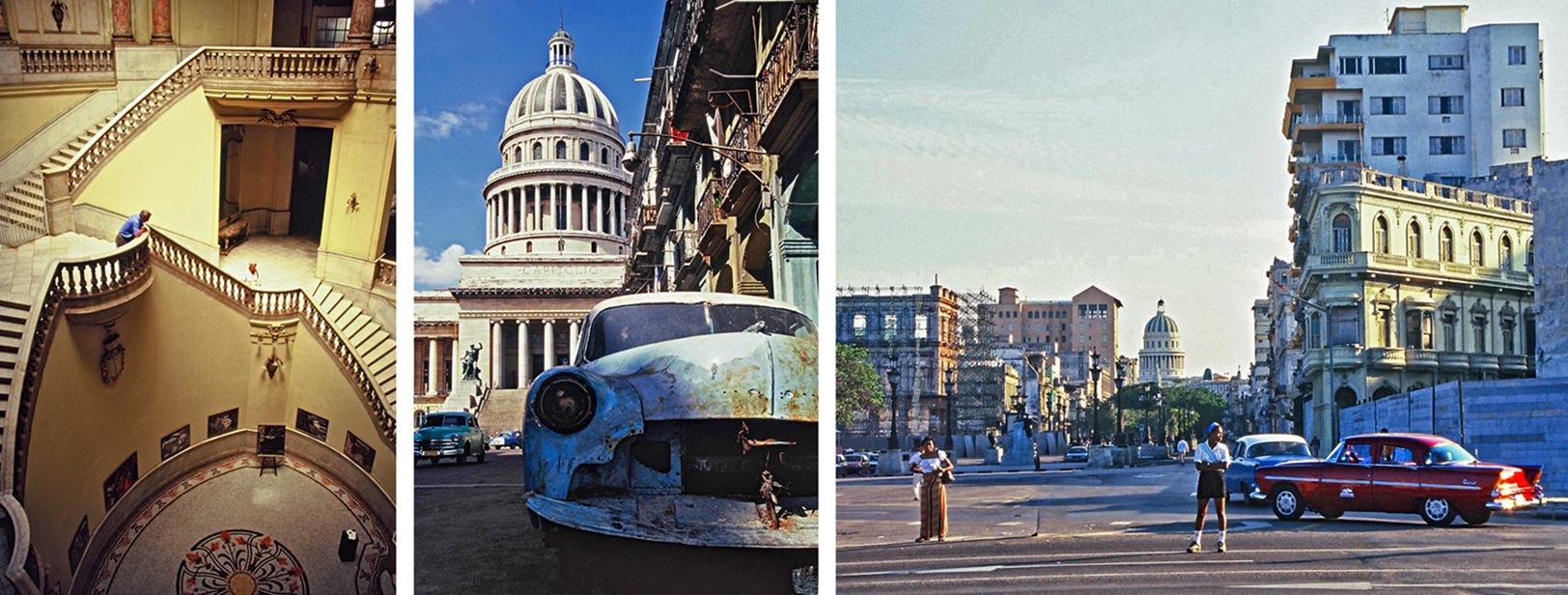
Havanna. Das Treppenhaus des Gran Teatro • Oldtimer vor dem Capitolio • Die Stelle am Ende des Paseo del Prado beim Malécon, die Historiador Eusebio Leal Spengler der Himmelswand zuwies. / Havana. The staircase of the Gran Teatro • Antique cars in front of the Capitolio • The spot at the end of the Paseo del Prado near the Malécon that Historiador Eusebio Leal Spengler allocated to the billboard
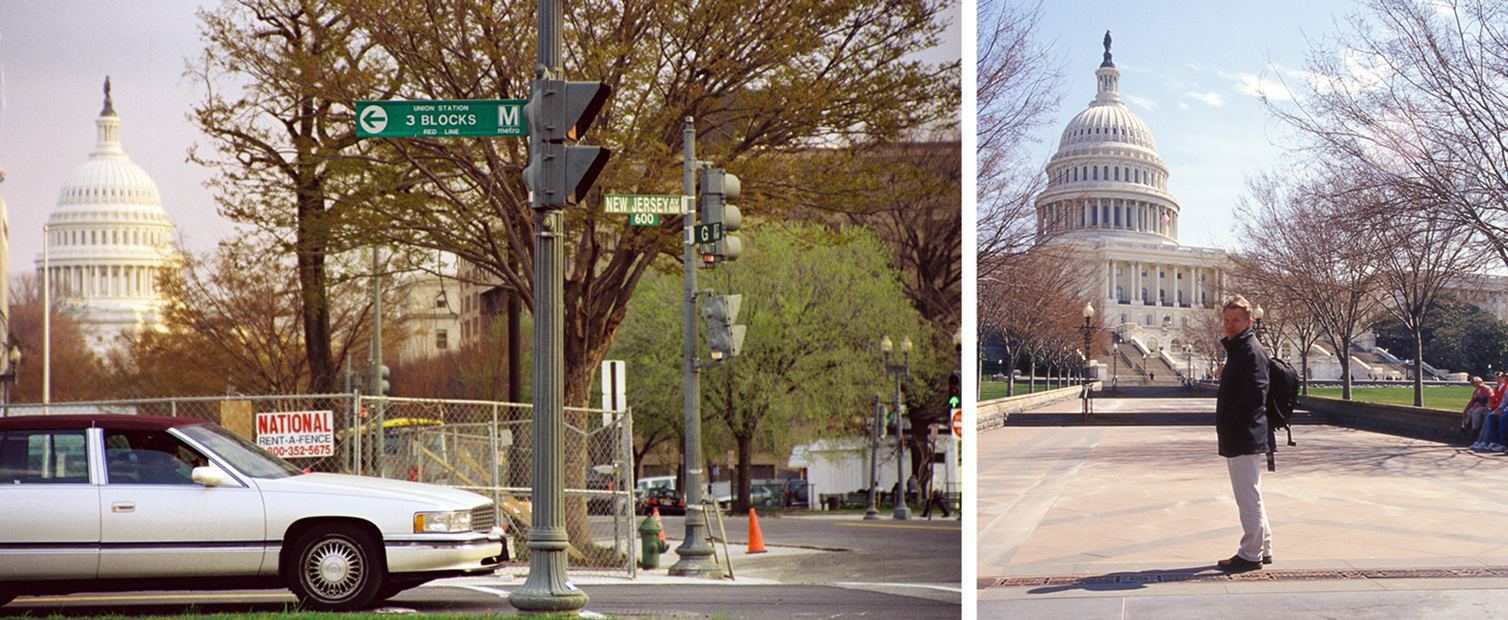
Washington D.C. Auf der Suche nach dem richtigen Standort • Michael Klant zwischen den öffentlichen Grünflächen der Mall vor dem Kapitol / Location scouting • Michael Klant in front of the Capitol building, flanked by public green space
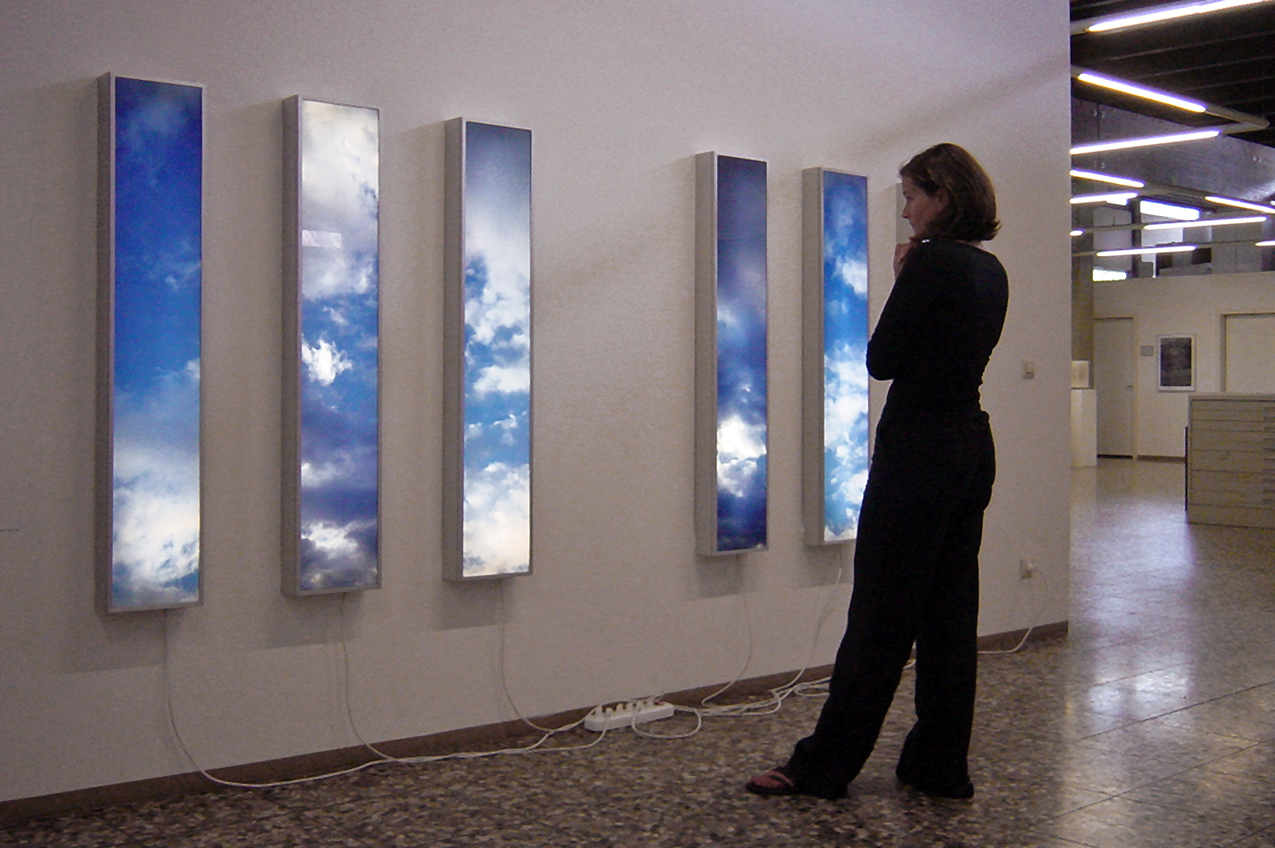
Interferenzen I, 2002. Zwei Fotos, aufgenommen über Washington und über Havanna, jeweils in drei Streifen zerschnitten und diese abwechselnd angeordnet, sechs Aluminium-Leuchtkästen, jeder 128 x 25 x 8,5 cm, gesamte Breite ca. 300 cm / Interference I, 2002. Two photos, taken over Washington and over Havana, each cut into three parts and arranged alternately, six aluminium light boxes, each 128 x 25 x 8,5 cm, altogether c. 300 cm
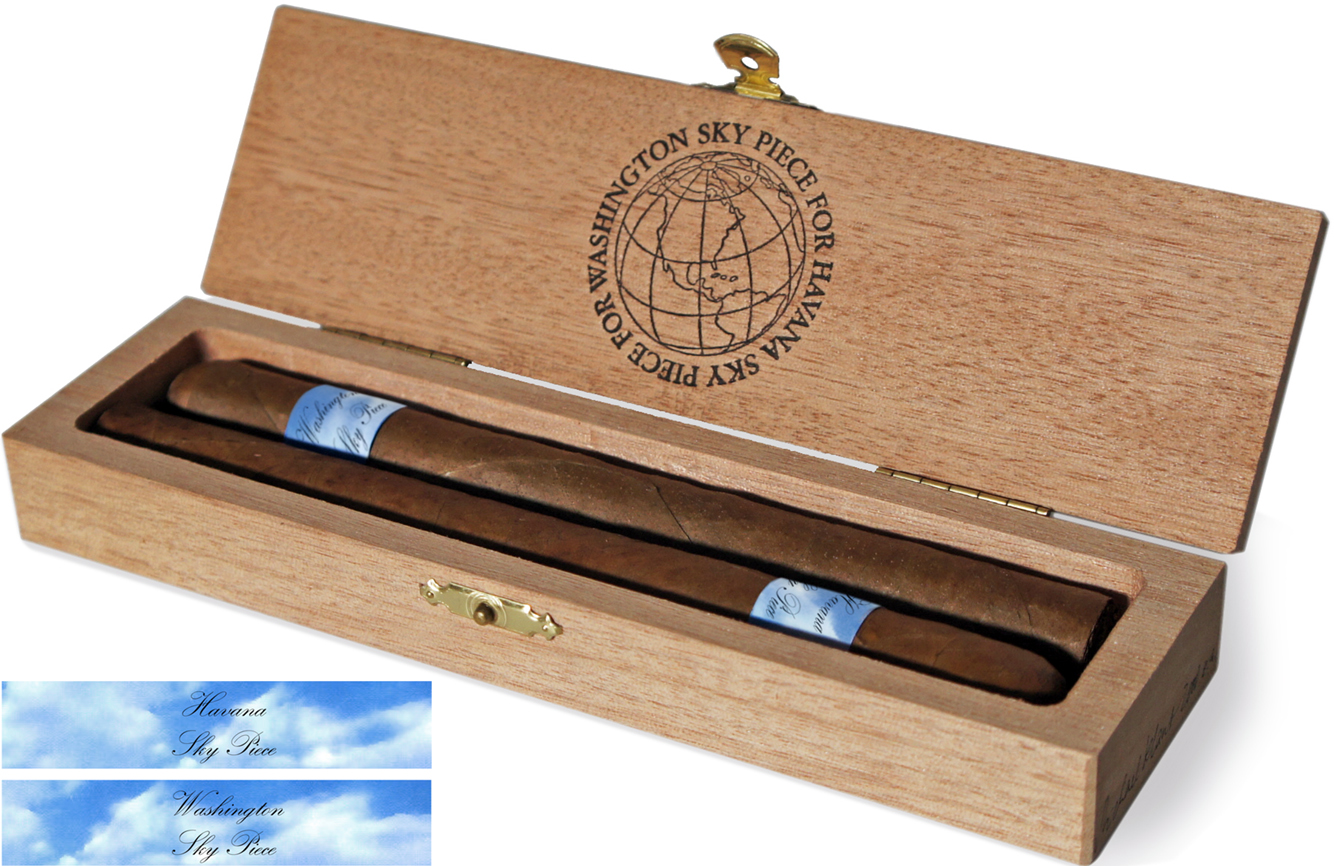
Romeo y Julieta, 2002. Zwei Zigarren mit Himmelsbanderolen in Holzkistchen mit Projekt-Brandzeichen, geschlossen 3 x 25 x 5,5 cm, Auflage 50 /Two cigars with sky banderoles in box with project brand mark, closed 3 x 25 x 5,5 cm, edition of 50
Projekt-Chronologie / Project chronology
Februar 2002: Reise nach Havanna, Treffen mit TV-Journalist Jochen Beckmann, der das Projekt für 3sat begleitet, und Dietmar Geisendorf, Kulturattaché der deutschen Botschaft in Havanna, der eine Ausstellung zum Thema Wolken in der Kunst plant, als Schritt zur erhofften Gründung eines Goethe-Instituts in Havana. Gespräch mit dem höchsten Zivilbeamten Kubas, dem Historiador Eusebio Leal Spengler, der das Projekt befürwortet und eine Aufstellung am Ende des Paseo del Prado im Frühsommer 2003 vorschlägt. Kennenlernen der Gruppe der Maler des Gran Teatro de la Habana unter Vorstand Omar Corrales Mora, die sich für die gemeinsame Arbeit begeistern. Die Menschen sind, trotz deutlicher Wirtschaftprobleme aufgrund des US-amerikanischen Embargos, sehr freundlich, gebildet und kommunikativ. Fotografieren von Wolken. /
February 2002: Journey to Havana, meeting with TV journalist Jochen Beckmann, who accompanies the project for the TV station 3sat, and Dietmar Geisendorf, cultural attaché at the German Embassy in Havanna, who plans an exhibition on clouds in art as a step to the hoped-for founding of a Goethe Institute in Havana. Conversation with the highest-ranking civil servant of Havana, the Historiador Eusebio Leal Spengler, who approves of the project and suggests the erection at the end of the Paseo del Prado in early summer 2003. Meeting the group of the scene painters at the Gran Teatro de la Habana and painting director Omar Corrales Mora, who are enthusiastic about the future collaboration. Despite apparent economic problems, people are friendly, literate and communicative. Photographing clouds.
März 2002: Reise nach Washington mit Damaris, Unterkunft bei Mark Kreitman, Staatsanwalt und Juraprofessor an der Georgetown University, Ehemann der Künstlerin Inga McCaslin Frick. Verhandlungen mit dem National Park Service, dem Staatlichen Gartenbauamt, über die Aufstellung einer Plakatwand auf einer der Wiesen der National Mall in Sichtweite zum Kapitol. Demonstrieren gehört hier zu den Grundrechten, doch eine Genehmigung zu bekommen ist schwierig und an viel Papierarbeit gebunden. Viele Menschen scheinen seit den Attacken des 11. September 2001 skeptisch und abweisend. Schließlich sichert das Corcoran College of the Arts and Design seine Unterstützung und Räumlichkeiten zu. Das Goethe-Institut in Washington möchte eine Ausstellung zum Projekt durchführen. /
March 2002: Journey to Washington with Damaris, staying with Mark Kreitman, litigator and law professor at Georgetown University, husband of artist Inga McCaslin Frick. Negotiations with the National Park Service about the construction of a billboard on a lawn of the National Mall in sight distance to the Capitol building. Holding a demonstration here is a fundamental right, but the permission is hard to get and causes a lot of paperwork. Many People seem sceptical and distant on account of the attacks of September 11, 2001. At last, the Corcoran College of the Arts and Design assures its support and workspace. The German Goethe Institute in Washington wants to arrange an exhibition.
Am 20. März 2002 beginnt US-Präsident George W. Bush den zweiten Irakkrieg mit einer Invasion. Bundeskanzler Schröder und Außenminister Fischer verweigern die Teilnahme Deutschlands. Historiador Eusebio Leal Spengler stoppt das Billboard-Projekt mit Bedauern. Seitdem gab es keinen neuen Anlauf. /
On March 20, 2003, U.S. President George W. Bush starts the Second Iraq War with an invasion. Federal Chancellor Schröder and Foreign Secretary Fischer decide not to join the war with Germany. Historiador Eusebio Leal Spengler stops the billboard project with regret. Since then, there has been no new attempt.
